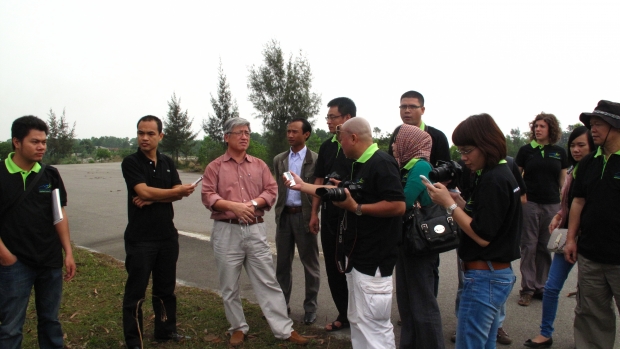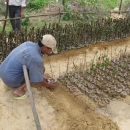Grants :: Small Grant Facilities :: Community-based restoration and management of mangroves in Lap An Lagoon, Thua Thien Hue
Community-based restoration and management of mangroves in Lap An Lagoon, Thua Thien Hue

Journalists interviewing Dr. Truong Van Tuyen - Director of ... , Lap An Lagoon, Thua Thien Hue, Viet Nam © IUCN Viet Nam
Objectives
- To enhance capacity and improve participation of the community based organization (Fisheries Association - FA) in mangrove protection, management and restoration;
- To develop mangrove management plan and environmental friendly livelihood by adjusting the activities for sustainable use and capture aquatic resources in supports of the mangroves management and restoration;
- To facilitate allocation of use rights over the lagoon resource and other institutional arrangements for community-based management and conservation of mangroves.
Background
Lap An Lagoon is located in Lang Co Town, Thua Thien Hue province. The lagoon area is 16.17 km2 with rich natural resources including mangroves. Among 9 hamlets in Lang Co Town, local livelihood activities are related to Lap An lagoon in 5 hamlets, namely Lap An, Loan Ly, An Dong 1, An Dong 2 and Dong Duong Hamlet. Aquaculture and fishing laborers account for 30% while oysters exploiting for lime production contributes 55% of livelihoods. Fishing gears including small mesh nets, lamps, lift nets, plant brush, steel frame traps and electric traps were used by hundreds of households, which increased pressure on the lagoon's resources. Dense and destructive fishing gears together with the expansion in aquaculture and oyster exploration for lime production further resulted in the degradation of the lagoon's ecosystem, decreasing fishery resources; having adverse impacts on the fishing community's livelihoods.
Some decades ago, there was a large area of mangroves; approximately 100 ha connected to the inter-tidal area in the western lagoon. During the 1990s, the mangroves here were diverse and included 18 species. Due to poor management and increasing demands from aquaculture and infrastructure development, the area of mangroves has been reduced. Before the project started in 2011,only about 15 ha of mangrove remained and was considered poor quality. These mangrove fragments were not classified as forest but as unused land that could be developed for other purposes. There was therefore no legal basis for mangrove protection, putting them in danger of being completely eradicated in this area. The concern was not only for the degradation of mangrove ecosystem and its biological value but also to put in place an effective strategy for conservation. Despite the efforts of different organizations, progress towards wetland conservation in Thua Thien Hue has faced many hurdles. Up to 2010, no wetland conservation zones were put in place or implemented. In response, this MFF/SGF proposal was designed to contribute to the restoration and conservation of mangroves in coastal wetland ecosystems.
Target beneficiaries
Effective management and restoration of the mangroves in Lap An Lagoon will contribute to conservation of the eco systems in Lap An lagoon where has great potentials for development of tourism and fishery that improve livelihoods for hundreds local households. In addition, this project will contribute to securing people’s life and livelihoods of thousands people living around the lagoon, especial to more than 2000 labors in An Dong 1 Hamlet and An Dong 2 Hamlet. Moreover, the mangroves restoration and conservation in local community will help to improve income for women who have no conditions to get jobs far from their families due to housework’s and responsibility for taking care children. The participatory approach in the project and community-based management are also good opportunities for women improving their positions in their families as well as in the community.
Outputs
- Establishment of a community-based organization and task force on mangroves and fishery conservation.
- Raise in awareness and build capacity of fishing association to mobilize the participation of local fishermen in mangrove conservation and management.
- A survey conducted on the existing mangrove area, recognizing them as part of a local forest protection plan so that the remaining mangroves can be legally protected.
- Establishment of a mangrove nursery and planting of seedlings to expand the remaining mangrove areas.
- Re-location and removal of destructive fishing gears to reduce the density of fishing gears for more sustainable fishing.
- Implementation of pilot mangroves-based polyculture models to encourage local households to realize mangroves values and replicate sustainable aquaculture methods.
Accomplishments and challenges
- NCB members visited Lap An Lagoon and made recommendations on mangrove restoration, including a focus on enabling natural regeneration of the existing mangroves rather than planting mangroves, to the grantee. However, it was hard for CCRD to negotiate with Chan May Lang Co Economic Zone Management Board to adjust the golf course plan.
- From 27-29 March, a field trip was organized for journalists as part of a UNDEF/CIFOR/MFF-funded training course for environmental journalists with the aim to involve media in advocacy for protection of this mangrove area. At the training, a brief of the golf course’s impacts on the environment was distributed to journalists for discussions. After the training, a number of features were published on different media channels.
- On 25 April, 2012, Deputy Prime Minister issued an official letter to Thua Thien Hue’s People’s Committee on the golf course construction in Lang Co, which stated that no protection forest (mangroves) area is allowed to be used for golf course construction.
- A community-based mangrove management mechanism was successfully established in Lang Co town, including:
- The institutionalization of Lang Co town's Fishing Association (FA) as a legal entity under the provincial FA. Members of Lang Co FA are aquatic resource users in Lap An Lagoon.
- The creation of task forces on mangroves and fishery resources protection within Lang Co FA.
- Results of the survey provided important inputs to the Provincial Forestry Sub-Agency to legally recognize 15.9 ha of mangroves in Lang Co lagoon as forest instead of unused land. The survey also helped to identify potential mangrove regeneration areas as a basis to focus investment on mangrove area expansion.
- After the survey was conducted, 10 ha of mangrove forest was allocated to 2 community groups for management by official decisions by the Phu Loc District People's Committee. These specified the rights and responsibilities of the local community in mangrove protection and also created favorable conditions for mangrove-based aquaculture and fishery resources protection. The allocation aimed to create the ownership for local community and link mangroves conservation with their livelihoods. They were allowed to widely use mangroves resources but were also obligated to protect them. This allocation is valid for 50 years with evaluations to be conducted every 5 years by local authorities. When the project ended, there had not been any regulations on mangrove stewardship allocation to local communities, hence this pilot case in Lang Co town has the potential to facilitate or promote the development and formulation of provincial regulation in the future.
- The project increased the capacity of Lang Co FA in undertaking restoration and protection of mangroves, including mangrove nurseries and planting techniques. About 6,000 mangrove seedlings have been raised and 5,000 replanted, applying Farmer Field School methods to the local community. This increased the lagoon's mangrove area by 3 ha in 2012-2013.
- Six pilot sustainable aquaculture models, including 3 shrimp, blue mussel models and 3 mangroves-based crab models were undertaken, which raised the income of households by 10% upon harvest. In particular, the 3 mangroves based crab models conducted by the 2 communities was able to show clear evidence of the mangroves' value and thus created an incentive for other households to replicate the model and protect mangroves.
- Regular patrols by mangrove protection task forces meant that there was a halt to mangrove cutting activities and destructive fishing gear in the lagoon. A member of the FA invested his own money in planting 2 ha of mangroves for mangrove polyculture activities.
Contributions to cross-cutting themes
- Climate Change
- Communications
Lessons Learned
- The case of the FA member investing his money in planting mangroves shows that once local people witness the benefits from mangrove conservation, they will be willing to protect mangroves.
- There is potential for conflict between resource users. The forest is allocated to a community, in particular a village and those who can afford the initial investment in mangrove re plantation and aquaculture are the only ones who can benefit from the mangroves and may not have any obligations to the community. In case of the project, there is an agreement between FA member; Vinh, and other members of the village that he will return the planted forest to village management after 5 years and participate in a benefit sharing regulation approved by the Commune and Lang Cotown People's Committee.
- Not many women participated in project activities. Although they did participate in mangroves nursery and re plantation activities, they were not confident to participate in public events and community activities. Therefore, more communication activities should be undertaken to call for the involvement of women in the FA.
- Although Circular 07/2011/TTLT- BNNPTNT- BTNMT stipulated that allocating forests is accompanied by allocating forest land, in Lang Co, the community was only allocated the forest. The forest itself is under the management of the Department of Natural Resources and Environment (DONRE) and the land use is under the control of Chan May Lang Co Economic Zone's management board. DONRE cannot officially agree to allocate forest land without the permission of the economic zone. As such, local communities do not have land tenure over their allocated forest, leading to many difficulties in protecting and managing the forest, especially in the case of violations. This needs follow-up from CCRD to advocate to the provincial government to clarify the function and mandates of DONRE and Chan May Lang Co Economic Zone.
Project Facts
Country
Location
The Lap An lagoon belongs to Lang Co Town, Phu Loc District, Thua Thien Hue Province. The lagoon area is 16.17 km2 and its depth is not equilateral from 0.5 to 3 m. The Lap An lagoon is located in monsoon tropical area and it is influenced by see-breeze.
Topic
- Climate change
- Civil Society Engagement
- Capacity Building
- Sustainable Livelihoods
- Community Resilence
- Coastal Governance
Duration
1st Oct 2011 to 31st Mar 2013
MFF Grant Amount
VND468,000,000
Implementing Partner
Dr. Truong Van Tuyen - Director
Centre for Community Research and Development (CCRD)
Address: 148 Bùi Thị Xuân, Hue City
Tel: 84-54 3523540
Fax: 84-54 3523540
E-mail: CCRD.huefis@gmail.com
